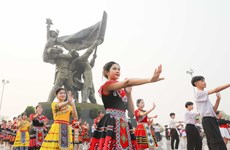Fresh air among the flowers outside Hanoi
A day trip to Me Linh Flower Village is a chance to escape from hustle and bustle and to fill one’s lungs with fresh air in flower fields after long days choking in Hanoi's polluted air.
 A farmer harvests chrysanthemums in his field. (Photo sapo.vn)
A farmer harvests chrysanthemums in his field. (Photo sapo.vn)Hanoi (VNA) - A day trip to Me Linh Flower Village is a chance to escape from hustle and bustle and to fill one’s lungs with fresh air in flower fields after long days choking in Hanoi's polluted air.
Located just 30km north of the capital, the area is a new flower hub offering fresh flowers for Hanoi and northern provinces.
Though it does not have long history like Ngoc Ha and Nhat Tan villages, Me Linh district now hosts more than 200ha of flower fields.
“Income from flowers has made significant changes to our life,’ said Trinh Van Phu, a local farmer. “In the past, we just planted rice, corn, vegetables and fruits.”
Flower fields featuring violet, gladiolus, mimosa, rose, daisy and lily have brought new colours for villages in Thanh Lam, Dai Thinh and Van Khe communes, where ithe roads have been cemented and bigger and more beautiful houses have been built. Many people have also bought cars and modern technology.
“We still live on agriculture but our living standards have greatly improved,” Phu said.
Few people would know that Me Linh was formed accidentally nearly 20 years ago, when Nguyen Van Loi, a student from the National Economics University, brought a Da Lat rose from a birthday party home to Me Linh district, which was then part of the northern province of Vinh Phuc.
At that time, such a rose was a rare and luxury item found on postcards only, Loi recalled.
“Passion for my future career drove me to graft the rose with wild rose plants popular in Me Linh fields,” he said.
The mixed rose plant grew well, to Loi’s surprise. He then spread the plant across his field with his older brother Nguyen Van Quy.
The first crop brought his family enough money to ease the loss of the family fish pond.
The family then grew more bumper flower crops, which inspired more households in the area to ask for help grafting plants, selecting genres and care techniques.
Gradually, flowers spread across the district, which now supplies flowers for northern provinces like Thanh Hoa, Bac Giang, Yen Bai, Ha Giang and even exports overseas.
Unlike planting rice and vegetables, farmers can plant flowers year-round.
Early in the morning and around 4pm in the afternoon, the fields are full of farmers busy cutting and caring for flowers. Bikes and cars driven by wholesalers flock to the fields to buy flowers at the same time.
Not only wholesalers, domestic and foreign tourists also visit to enjoy the immense flower fields.
“We like this flower field as it is not too busy like the ones in Hanoi,” said Phi Thanh Duc, who took his wedding photos in the field. “It’s not also too far to travel during the day. The atmosphere here is so fresh and cool.”
Le Thanh Mai, a student from Hanoi, said she liked the flower market as there were many kinds of flowers on all corners of the rural roads.
“I spent my time filling my lungs with the fresh air and scent of flowers, and also taking a lot of wonderful selfies and 'wefies' with my friends," she said.
According to local farmers, the best time to visit Me Linh is between the 12th lunar month and the third lunar month of the new year, when many kinds of flowers come to full bloom to prepare for Tet (lunar New Year).
Land of heroines
Me Linh was the residential area of generals during the Hung King’s era in early history.
The fertile land used to be an economic and cultural exchange centre between mountainous, mid-land and neighbouring areas of Thang Long Citadel.
Like other historical locations in the country, Me Linh district now hosts various historical sites including communal houses, temples and archaeological sites.
Thanh Den archaeological site in Tu Lap commune was first discovered in 1970. Objects unearthed included stone, bronze and ceramic objects, including many bronze casts.
Scientists confirmed that Thanh Den used to be not only a residential area but also an important bronze casting centre dating back to the 15th century BC.
The land was also where the two Trung sisters (who lived between 14 AD and 43 AD) spent their childhood, grew up and started their revolution against Chinese invaders (between 40-43 AD). After their victory in 43 AD, the older Trung Trac came to throne and claimed the area the capital of Linh Nam State (early name of Vietnam).
Their revolution was the first armed revolution of the Vietnamese people, which overthrew Chinese power lasting more than 200 years.
The two sisters are considered the first heroines of the Vietnamese people.
Every year, Hai Ba Trung Temple hosts a festival on 4-10th of lunar first month, the same days the two sisters gathered their troops. The main day is the sixth, when people organise worship ceremonies for the two sisters and various folk games to entertain locals.
That’s why among more than 100 temples dedicated to the Trung sisters in nine provinces and cities in the north, the temple to them in Ha Loi village, Me Linh commune, Me Linh district is most important./.













